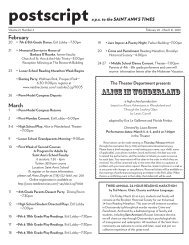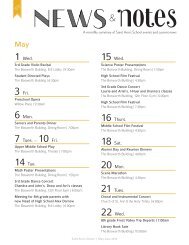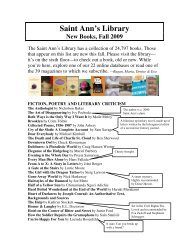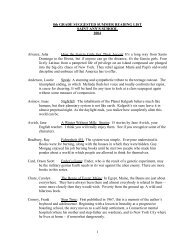Mathematical Journeys - Saint Ann's School
Mathematical Journeys - Saint Ann's School
Mathematical Journeys - Saint Ann's School
You also want an ePaper? Increase the reach of your titles
YUMPU automatically turns print PDFs into web optimized ePapers that Google loves.
<br />
58 <br />
the above case would be described as: <br />
K2=2 <br />
M3=1 <br />
M4=1 <br />
<br />
This notation guarantees that with a given l and given M and K values, we can <br />
compute p by subtracting from the maximum case as described before. We <br />
developed a Diophantine equation (or rather, an equation template of sorts) to <br />
represent the situation. Here is an example of its application: <br />
C(l, 2) ‐ p = k2 C(2,2) + k3 C(3,2) + ... + m3 [C(3,2) ‐ 1] + m4 [C(4,2) ‐ 1] + ... <br />
<br />
So far, so good. But when we got to this point, we realized something <br />
unsettling that made this problem even more complicated than it already <br />
appeared. There can exist what we termed “overlaps,” i.e. lines that are counted <br />
in more than one group of parallel or coincident lines. It would be nice if the <br />
product of all M and K indices and values equaled exactly l, but this is not always <br />
the case: <br />
<br />
<br />
<br />
<br />
<br />
<br />
<br />
<br />
<br />
<br />
<br />
<br />
<br />
In many ways, the pattern of our course through this problem was marked by <br />
two things: classification and specialization. We built an entire notational system <br />
and used it only to solve a very particular special case of the original problem. <br />
But in the process, I think it’s fair to say that the development of the questions <br />
themselves provided a great deal better understanding of the problem than I had <br />
at outset. <br />
Before I get to what the special case was, I need to introduce the “valance” <br />
system I designed to deal with overlaps. <br />
Here's a way to visualize our classification system for configurations of lines, <br />
while accounting for overlaps between multiple M/K groups: <br />
Draw a group of dots to represent each M/K group. Connect these dots, or <br />
valances, with “lines” to illustrate the overlaps. However, our definition of “line” <br />
is not what one might expect: consider the case where more than two M/K <br />
groups share a line. This is represented in the new system as lines emanating <br />
from all of the groups involved, and converging, becoming a single “line.” Each <br />
valance in the new system represents a line, unless it is connected to one or more <br />
other valances, in which case it represents the same line as do those. <br />
<br />
<br />
K2=1 <br />
M3=1 <br />
<br />
Here, the topmost <br />
horizontal line belongs <br />
to both a pair of parallel <br />
lines and a group of 3 <br />
coinciding lines.
















